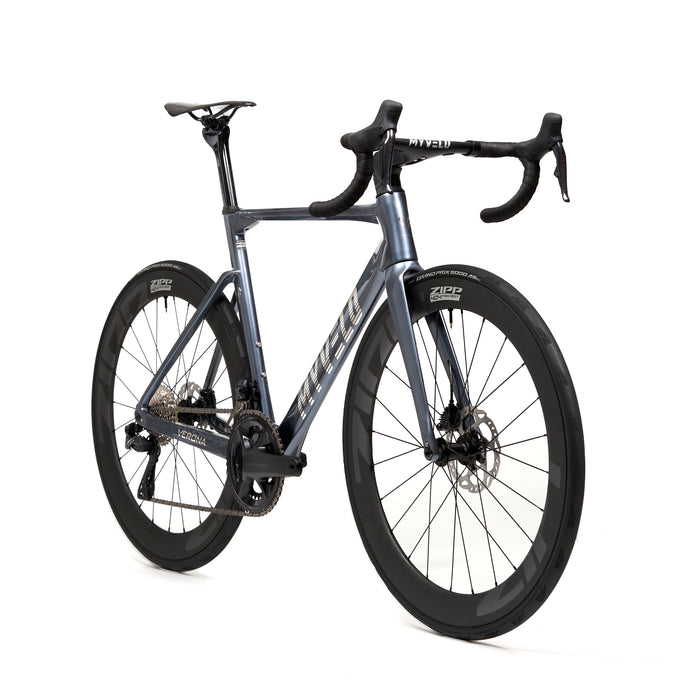
Verona road bike
incl. FREE shipping & free returns

Von Lukas Vogt |
3 minutes read time

Now that you understand what VO2Max is and why it is so important for your performance on the road bike, it is now time to look at how you can specifically improve this crucial metric.
When it comes to improving VO2Max, interval training is probably the most effective method. Particularly intense intervals (such as high intensity interval training, HIIT) push your maximum oxygen uptake to the limit and promote your aerobic capacity. With interval training, you alternate between phases of maximum exertion and short recovery phases. This method quickly gets your pulse up to full speed, which sustainably increases your VO2Max.
You can incorporate this training into your training plan 1-2 times a week to work specifically on your VO2Max. Make sure that you really push yourself to the limit during the intensive phases, as this is the only way to achieve the maximum effect.
In addition to interval training, it is important to complete intensive sessions regularly. Your cardiovascular system adapts to the strain, and the more often you challenge it, the better it will be at absorbing oxygen. In addition to the classic intervals, you should also integrate long rides into your training plan. These increase your basic endurance and improve your overall aerobic capacity.
A good mix of short, intense sessions and longer, moderate rides is the key. This is what a typical weekly plan might look like:
Patience is a virtue when it comes to improving VO2Max. You won't see significant improvements overnight, but with consistent training, you'll see results in about 6 to 8 weeks.
It also depends on your current training level. Beginners or those returning to cycling can see progress more quickly, while experienced riders have to work harder to achieve small improvements. It is important that you continually adapt your training and regularly work on your VO2Max without falling into overtraining.
An often overlooked factor in improving VO2Max is proper nutrition and adequate recovery. Your body not only needs training, but also the right nutrients to recover and adapt to the strain.
Nutritional tips to support VO2Max increase:
Hydration is also crucial. Even slight dehydration can affect your VO2Max and performance. Make sure you drink enough before, during and after training, especially on hot days or during intense sessions.
In addition to nutrition, recovery plays a crucial role. After intensive sessions, your body needs time to regenerate and adapt. Without sufficient recovery, you not only risk injury, but also prevent the training effect.
Therefore, plan regular rest days and pay attention to the signals from your body. If you feel constantly tired and exhausted, you should reduce the intensity for a few days. Active regeneration such as easy rides or light stretching can help to get your body back up to speed more quickly.
Improving your VO2Max is a long-term process that requires regular and intensive training. Interval training and long rides are the most effective ways to maximize your oxygen uptake. But don't forget: nutrition and recovery also play an important role in getting the most out of your training.
Stick with it, be patient and work continuously on your VO2Max - this will take your road bike performance to a new level in the long term. In the next article in this series, you will learn how to measure your VO2Max and optimally track your progress!

Als Rennradfahrer möchte man möglichst ständig besser werden: schneller, ausdauernder und effizienter. Doch was, wenn der Schlüssel zu diesen Zielen nicht nur auf zwei Rädern liegt? Rudern, oft unterschätzt, bietet eine ideale Ergänzung zum Radtraining. Es trainiert nicht nur den ganzen Körper, sondern verbessert auch die Ausdauer, Kraft und Stabilität – entscheidende Faktoren für jeden Radsportler.

Nach einer intensiven Rennrad-Einheit ist die richtige Regeneration entscheidend, um Leistung zu verbessern, Verletzungen zu vermeiden und langfristig Fortschritte zu erzielen. Doch wie sieht eine effektive Erholung aus? Hier bekommst Du die besten Tipps zur optimalen Regeneration nach dem Rennradtraining.

Erfahre, wie Radsport-Ligen aufgebaut sind und weitere Infos zur Organisation im Profi-Radsport!